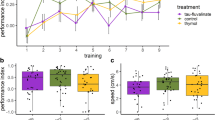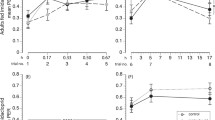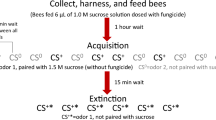Abstract
Chlorpyrifos is an organophosphate pesticide used around the world to protect food crops against insects and mites. Despite guidelines for chlorpyrifos usage, including precautions to protect beneficial insects, such as honeybees from spray drift, this pesticide has been detected in bees in various countries, indicating that exposure still occurs. Here, we examined chlorpyrifos levels in bees collected from 17 locations in Otago, New Zealand, and compared doses of this pesticide that cause sub-lethal effects on learning performance under laboratory conditions with amounts of chlorpyrifos detected in the bees in the field. The pesticide was detected at 17 % of the sites sampled and in 12 % of the colonies examined. Amounts detected ranged from 35 to 286 pg.bee−1, far below the LD50 of ~100 ng.bee−1. We detected no adverse effect of chlorpyrifos on aversive learning, but the formation and retrieval of appetitive olfactory memories was severely affected. Chlorpyrifos fed to bees in amounts several orders of magnitude lower than the LD50, and also lower than levels detected in bees, was found to slow appetitive learning and reduce the specificity of memory recall. As learning and memory play a central role in the behavioral ecology and communication of foraging bees, chlorpyrifos, even in sublethal doses, may threaten the success and survival of this important insect pollinator.




Similar content being viewed by others
References
Al-Naggar Y, Codling G, Vogt A, Naiem E, Mona M et al (2015) Organophosphorus insecticides in honey, pollen and bees (Apis mellifera L.) and their potential hazard to bee colonies in Egypt. Ecotoxicol Environ Saf 114:1–8
Avarguès-Weber A, de Brito Sanchez MG, Giurfa M, Dyer AG (2010) Aversive reinforcement improves visual discrimination learning in free-flying honeybees. PLoS One 5:e15370
Balbuena M, Tison L, Hahn M, Greggers U, Menzel R et al (2015) Effects of sub-lethal doses of glyphosate on honeybee navigation. J Exp Biol 218:2799–2805
Bates D, Maechler M, Bolker, B (2012) lme4: linear mixed-effects models using S4 classes. R package version 0.999999–0
Blacquière T, Smagghe G, Gestel C, Mommaerts V (2012) Neonicotinoids in bees: a review on concentrations, side-effects and risk assessment. Ecotoxicology 21:973–992
Celli G, Maccagnani B (2003) Honey bees as bioindicators of environmental pollution. Bull Insect 56:137–139
Cutler GC, Purdy J, Giesy JP, Solomon KR (2014) Risk to pollinators from the use of chlorpyrifos in the United States. Rev Environ Contam Toxicol 231:219–265
Davie-Martin CL, Hageman KJ, Chin Y-PP (2013) An improved screening tool for predicting volatilization of pesticides applied to soils. Environ Sci Technol 47:868–876
De Stefano LA, Stepanov II, Abramson CI (2014) The first order transfer function in the analysis of agrochemical data in honey bees (Apis mellifera L.): Proboscis extension reflex (PER) studies. Insects 5:167–198
Decourtye A, Armengaud C, Renou M, Devillers J, Cluzeau S et al (2004a) Imidacloprid impairs memory and brain metabolism in the honeybee (Apis mellifera L.). Pestic Biochem Physiol 78:83–92
Decourtye A, Devillers J, Cluzeau S, Charreton M, Pham-Delègue M-H (2004b) Effects of imidacloprid and deltamethrin on associative learning in honeybees under semi-field and laboratory conditions. Ecotoxicol Environ Saf 57:410–419
Decourtye A, Devillers J, Genecque E, Le Menach K, Budzinski H et al (2005) Comparative sublethal toxicity of nine pesticides on olfactory learning performances of the honeybee Apis mellifera. Arch Environ Contam Toxicol 48:242–250
Dobson HEM (2006) Relationship between floral fragrance composition and type of pollinator. In: Pichersky E, Dudareva N (eds.). Biology of floral scent. CRC Press 2006, pp 147–198
Dötterl S, Vereecken N (2010) The chemical ecology and evolution of bee–flower interactions: a review and perspectives. Can J Zool 88:668–697
EFSA (European Food Safety Authority) (2014) Conclusion on the peer review of the pesticide human health risk assessment of the active substance chlorpyrifos. EFSA J 12:3640
El-Hassani AK, Dacher M, Gary V, Lambin M, Gauthier M et al (2008) Effects of sublethal doses of acetamiprid and thiamethoxam on the behavior of the honeybee (Apis mellifera). Arch Environ Contam Toxicol 54:653–661. doi:10.1007/s00244-007-9071-8
EPA (Environmental Protection Agency) (2015) Chlorpyrifos: Revised human health risk assessment. Environmental Protection Agency, USA
Farina WM, Grüter C, Díaz PC (2005) Social learning of floral odours inside the honeybee hive. Proc Biol Sci 272:1923–1928
Farina W, Grüter C, Acosta L, Cabe S (2006) Honeybees learn floral odors while receiving nectar from foragers within the hive. Naturwissenschaften 94:55–60
Feltham H, Park K, Goulson D (2014) Field realistic doses of pesticide imidacloprid reduce bumblebee pollen foraging efficiency. Ecotoxicology 23:317–323
Fischer J, Müller T, Spatz A-K, Greggers U, Grünewald B et al (2014) Neonicotinoids interfere with specific components of navigation in honeybees. Plos One 9:e91364
Friesen LJ (1973) The search dynamics of recruited honey bee Apis mellifera. Biol Bull 144:107–131
Gauthier M, Grünewald B (2012) Neurtransmitter systems in the honeybee brain: Functions in learning and memory. In: Galizia CG, Eisenhardt D, Giurfa M (eds) Honeybee neurobiology and behavior. Springer Verlag, Heidelberg, pp 155–169
Gil M, de Marco R (2005) Olfactory learning by means of trophallaxis in Apis mellifera. J Exp Biol 208:671–680
Gill RJ, Ramos-Rodriguez O, Raine NE (2012) Combined pesticide exposure severely affects individual- and colony-level traits in bees. Nature 491:105–108
Guerrieri F, Schubert M, Sandoz J-CC, Giurfa M (2005) Perceptual and neural olfactory similarity in honeybees. PLoS Biol 3:e60
Guez D, Zhu H, Zhang S, Srinivasan M (2010) Enhanced cholinergic transmission promotes recall in honeybees. J Insect Physiol 56:1341–1348
Henry M, Béguin M, Requier F, Rollin O, Odoux J-F et al (2012) A common pesticide decreases foraging success and survival in honey bees. Science 336:348–350
Herbert L, Vazquez D, Arenas A, Farina W (2014) Effects of field-realistic doses of glyphosate on honeybee appetitive behaviour. J Exp Biol 217:3457–3464
Jaeger T (2008) Categorical data analysis: away from ANOVAs (transformation or not) and towards logit mixed models. J Mem Lang 59:434–446
Johnson R, Ellis M, Mullin C, Frazier M (2010) Pesticides and honey bee toxicity - USA. Apidologie 41:312–331
Katz EJ, Cortes VI, Eldefrawi ME (1997) Chlorpyrifos, parathion, and their oxons bind to and desensitize a nicotinic acetylcholine receptor: relevance to their toxicities. Toxicol Appl Pharmacol 146:227–236
Kessler S, Tiedeken E, Simcock K, Derveau S, Mitchell J et al (2015) Bees prefer foods containing neonicotinoid pesticides. Nature 521:74–76
Kosmidis I (2007) brglm: bias reduction in binary-response GLMs
Lambert O, Piroux M, Puyo S, Thorin C, L’Hostis M et al (2013) Widespread occurrence of chemical residues in beehive matrices from apiaries located in different landscapes of western France. PLoS One 8:e67007
Lavin K, Hageman K (2013) Contributions of long-range and regional atmospheric transport on pesticide concentrations along a transect crossing a mountain divide. Environ Sci Technol 17:1390–1398
Lavin K, Hageman K, Marx S, Dillingham P, Kamber B (2012) Using trace elements in particulate matter to identify the sources of semivolatile organic contaminants in air at an alpine site. Environ Sci Technol 46:268–276
Lunden J, Mayer D, Johansen C, Shanks C, Eves J (1986) Effects of chlorpyrifos insecticide on pollinators. Am Bee J 126:441–444
Lusebrink I, Girling RD, Farthing E, Newman TA, Jackson CW et al (2015) The effects of diesel exhaust pollution on floral volatiles and the consequences for honey bee olfaction. J Chem Ecol 41:904–912
Mackay D, Giesy J, Solomon K (2014) Fate in the environment and long-range atmospheric transport of the organophosphorus insecticide, chlorpyrifos and its oxon. Rev Environ Contam Toxicol 231:35–76
Matsumoto Y, Menzel R, Sandoz J-CC, Giurfa M (2012) Revisiting olfactory classical conditioning of the proboscis extension response in honey bees: a step toward standardized procedures. J Neurosci Methods 211:159–167
Ministry for Primary Industries (2012) Food residue surveillance programme 2011–2012 quarterly report. ISBN No: 978-0-478-40047-2
Morzycka B (2002) Simple method for the determination of trace levels of pesticides in honeybees using matrix solid-phase dispersion and gas chromatography. J Chromatogr A 982:267–273
Mullin CA, Frazier M, Frazier JL, Ashcraft S, Simonds R et al (2010) High levels of miticides and agrochemicals in North American apiaries: implications for honey bee health. PLoS One 5:e9754
NZEPA (New Zealand Environmental Protection Authority) (2013) Application for the reassessment of a group of hazardous substances under Section 63 of the Hazardous Substances and New Organisms Act 1996
Palmer MJ, Moffat C, Saranzewa N, Harvey J, Wright GA et al (2013) Cholinergic pesticides cause mushroom body neuronal inactivation in honeybees. Nat Commun 4:1634
Pareja L, Colazzo M, Pérez-Parada A, Niell S, Carrasco-Letelier L et al (2011) Detection of pesticides in active and depopulated beehives in Uruguay. Int J Environ Res Public Health 8:3844–3858
Perry C, Søvik E, Myerscough M, Barron A (2015) Rapid behavioral maturation accelerates failure of stressed honey bee colonies. Proc Natl Acad Sci U S A 112:3427–3432
Pohanka M (2011) Cholinesterases, a target of pharmacology and toxicology. Biomed Pap Med Fac Univ Palacky Olomouc Czech Repub 155:219–223
R Core Team (2013) R: A language and environment for statistical computing. R Foundation for Statistical Computing, Vienna
Racke KD (1993) Environmental fate of chlorpyrifos. Rev Environ Contam Toxicol 131:1–150
Raine N, Chittka L (2008) The correlation of learning speed and natural foraging success in bumble-bees. Proc R Soc B 275:803–808
Reinhard J, Srinivasan MV (2009) The role of scents in honey bee foraging and recruitment. In: Jarau S, Hrncir M (eds) Food exploitation by social insects: ecological, behavioral, and theoretical approaches 1. CRC Press/Taylor & Francis Group, Boca Raton, pp 65–182
Roussel E, Carcaud J, Sandoz J-C, Giurfa M (2009) Reappraising social insect behavior through aversive responsiveness and learning. PLoS One 4:e4197
Rundlöf M, Andersson G, Bommarco R, Fries I, Hederström V et al (2015) Seed coating with a neonicotinoid insecticide negatively affects wild bees. Nature 521:77–80
Sanchez-Bayo F, Goka K (2014) Pesticide residues and bees—a risk assessment. PLoS One 9:e94482
Scheiner R, Erber J, Page RE (1999) Tactile learning and the individual evaluation of the reward in honey bees (Apis mellifera L.). J Comp Physiol A 185:1–10
Scheiner R, Barnert M, Erber J (2003) Variation in water and sucrose responsiveness during the foraging season affects proboscis extension learning in honey bees. Apidologie 34:67–72
Shahpoury P, Hageman K, Matthaei C, Magbanua F (2013) Chlorinated pesticides in stream sediments from organic, integrated and conventional farms. Environ Pollut 181:219–225
Shapira M, Thompson C, Soreq H, Robinson G (2001) Changes in neuronal acetylcholinesterase gene expression and division of labor in honey bee colonies. J Mol Neurosci 17:1–12
Solomon KR, Williams WM, Mackay D, Purdy J, Giddings JM et al (2014) Properties and uses of chlorpyrifos in the United States. Rev Environ Contam Toxicol 231:13–34
Stanley DA, Garratt MP, Wickens JB, Wickens VJ, Potts SG et al (2015) Neonicotinoid pesticide exposure impairs crop pollination services provided by bumblebees. Nature 528:548–550
Stevenson J (1978) The acute toxicity of unformolated pesticides to worker honey bees (Apis mellifera L.). Plant Pathol 27:38–40
Tan K, Chen W, Dong S, Liu X, Wang Y et al (2014) Imidacloprid alters foraging and decreases bee avoidance of predators. PLoS One 9:e102725
van der Sluijs J, Simon-Delso N, Goulson D, Maxim L, Bonmatin J-M et al (2013) Neonicotinoids, bee disorders and the sustainability of pollinator services. Curr Opin Environ Sustain 5:293–305
Vergoz V, Roussel E, Sandoz J-C, Giurfa M (2007) Aversive learning in honeybees revealed by the olfactory conditioning of the sting extension reflex. PLoS One 2:e288
von Frisch K (1993) The dance language and orientation of bees. Harvard University Press, Cambridge, MA
Watts M (2013) Chlorpyrifos. Pesticide action network Asia and the pacific. Penang, Malaysia
Weick J, Thorn R (2002) Effects of acute sublethal exposure to coumaphos or diazinon on acquisition and discrimination of odor stimuli in the honey bee (Hymenoptera: Apidae). J Econ Entomol 95:227–236
Wenner AM, Wells PH, Johnson DL (1969) Honey bee recruitment to food sources: olfaction or language? Science 164:84–86
Williamson SM, Wright GA (2013) Exposure to multiple cholinergic pesticides impairs olfactory learning and memory in honeybees. J Exp Biol 216:1799–1807
Williamson S, Moffat C, Gomersall M, Saranzewa N, Connolly C et al (2013) Exposure to acetylcholinesterase inhibitors alters the physiology and motor function of honeybees. Front Physiol 4:13
Wright GA, Schiestl FP (2009) The evolution of floral scent: the influence of olfactory learning by insect pollinators on the honest signalling of floral rewards. Funct Ecol 23:841–851
Yang E, Chuang Y, Chen Y, Chang L (2008) Abnormal foraging behavior induced by sublethal dosage of imidacloprid in the honey bee (Hymenoptera: Apidae). J Econ Entomol 107:1743–1748
Acknowledgments
Marsden Fund Grant UOO1207
Author information
Authors and Affiliations
Corresponding author
Rights and permissions
About this article
Cite this article
Urlacher, E., Monchanin, C., Rivière, C. et al. Measurements of Chlorpyrifos Levels in Forager Bees and Comparison with Levels that Disrupt Honey Bee Odor-Mediated Learning Under Laboratory Conditions. J Chem Ecol 42, 127–138 (2016). https://doi.org/10.1007/s10886-016-0672-4
Received:
Revised:
Accepted:
Published:
Issue Date:
DOI: https://doi.org/10.1007/s10886-016-0672-4




